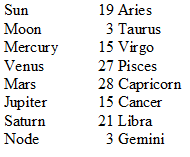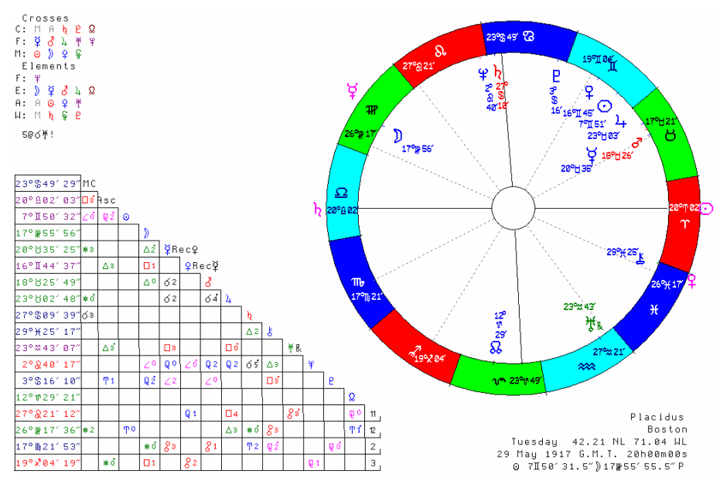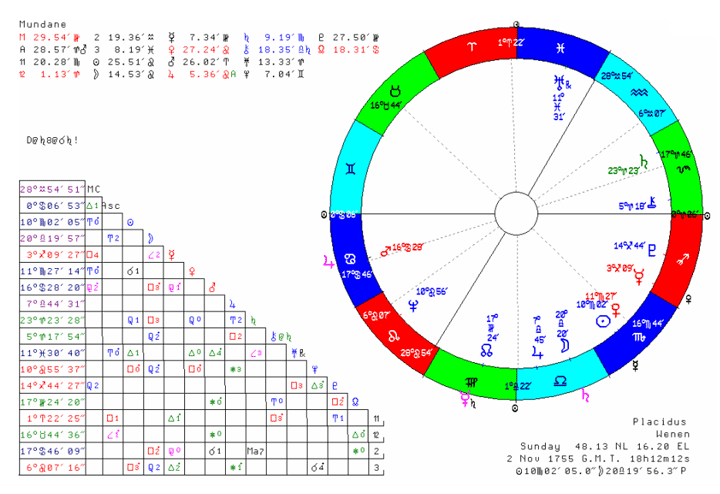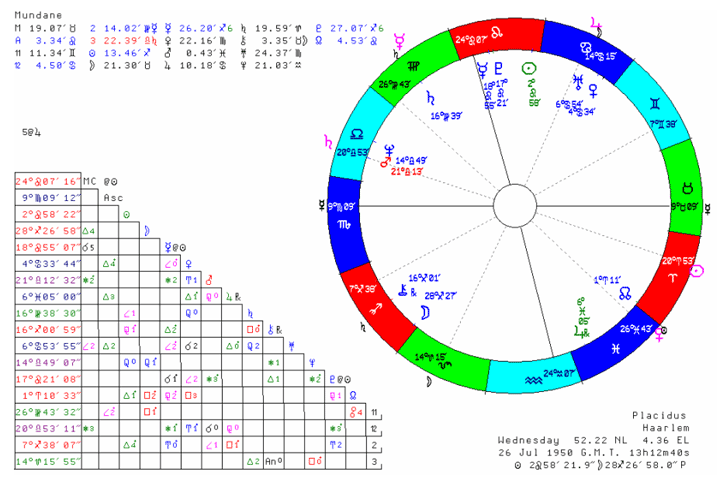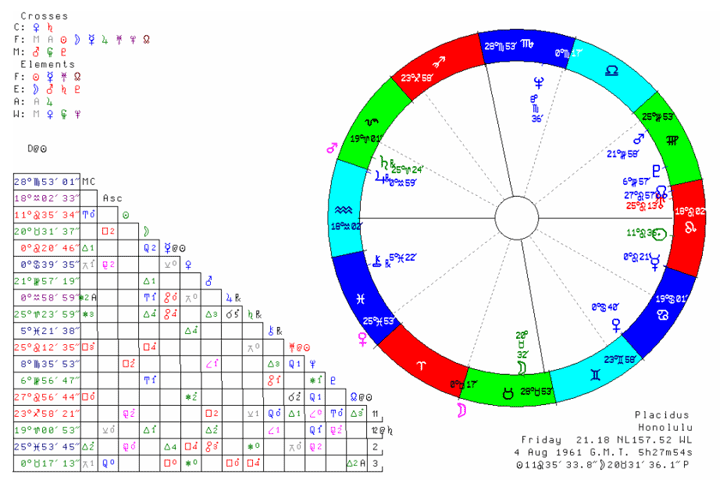Wim van Dam's Corner
|
|
In astrological tradition the sun, the moon, the five classical planets and the Northern Node are said to be exalted each in one sign. Sometimes they are even said to have their highest and purest influence when placed in this sign. Some authors however not only mention these signs of exaltation but also the degree within each sign that this exaltation presumably is associated with, thus: Mercury is the only planet that has got its exaltation in a sign that it rules too. Of these eight positions, six form an opposition in sign (although not in degrees) with another one: Leaving the moon and the node unpaired. Since the node’s degree of exaltation is often not mentioned, this may be the reason why some authors in the past have allotted Uranus’ exaltation to Scorpio, opposed to the “lonely” position of the moon in Taurus, thus completing the scheme to four pairs of opposed planets. One might also pair these degrees not by opposition of signs but by number of degrees: It is remarkable that the small benefic, Venus, has its exaltation in Pisces, traditionally ruled by the great benefic, Jupiter, while the small malefic Mars has its exaltation in Capricorn, ruled by the great malefic, Saturn. In the opposite signs, Virgo and Cancer, the two pairs have a weak position.
Most authors do not mention these exaltation degrees at all, f.e. Hone (p. 144). Frawley mentions them in the table at p. 80 and on p. 79. He notes; “Exaltation is more exalted yet at the particular degree given for each planet”, without mentioning any source or giving an example from his own practice. Morin on the very first page of chapter XXI of his Astrologia Gallica, without mentioning them, seems to implicitly discard them, together with other what he clearly thinks nonsensical stuff, although he is most certainly convinced of the value of exaltation in the signs. Wilson (p. 96) suggests they were added by more recent researchers (“astronomers”) limited the effect of exaltation to degrees in stead of to whole signs. Lilly 1 (p. 57-99) only mentions the degree of exaltation of a few planets and on p. 102 in striking contradiction to Frawley he explicitly states that if a planet is in the sign of its exaltation it does not matter “whether he be neer the very degree of his exaltation yea or not.” In Lily 2) even less information is given. When explaining exaltation Simmonite (p. 14) does not mention the degrees either, and so does Sepharial (p.17). Alan Leo (p.27) meticulously mentions them in a table but clearly is all alone at sea when he tries to find their significance. Several authors have tried to give an explanation for the distribution of these degrees amongst the zodiac. Since each of these explanations is rather convincing in its own but no more than any of the other ones we will not dwell upon them here. Also in this article we will not discuss the value of the planets in their respective signs of exaltation but take it for granted, as tradition says, that they have an outspoken positive value when positioned there in any degree and a negative one in the opposite sign, where it is in its fall. What matters here now is this question: do these traditional degrees of exaltation have any astrological significance?
In this article I will defend the view that a planet that is in conjunction with another planet’s degree of exaltation should be considered to be in conjunction to that planet itself, wherever that ruling planet is positioned in the horoscope. Of course, the planet’s actual position does not lose its significance and should be carefully analyzed, but the virtual conjunction with the planet of exaltation is as important position in the horoscope and gives information that is otherwise unattainable. An orb of three degrees is allowed. A planet in its own degree of exaltation may be considered to be very strongly positioned but it is probably useless to speak of a conjunction with itself and I honestly wouldn’t know how to evaluate the difference in quality between a planet in its own degree of exaltation and the same planet, ‘only’ in its sign of exaltation. Slightly different is the position of a cusp in a degree of exaltation. Here the best reading is mostly given not by projecting the cusp on the ruling planet but by projecting the planet on the cusp. The difference may seem trifling but I have found it really helpful to see it this way. The interpretation is simply the same as you would do if the planet really were in conjunction to this cusp, reckoning with both the significance of the cusp and of the ruling planet. The ascendant, as may be expected, shows the influence at its strongest.
A nice illustration of this last remark is given by the horoscope of John F. Kennedy (degrees of exaltation indicated with pink glyphs outside the zodiacal circle wherever a radical point is conjunct to them):
We see that the ascendant is in Saturn’s degree of exaltation. Since Saturn is in its detriment (Cancer) in ten, we see here a general influence (a badly positioned Saturn in ten, meaning a huge fall in his career) made individual by the ascendant’s degree. Please note the remarkable position of Chiron, in my view the real ruler of Libra, in Venus’ degree of exaltation at the cusp of the sixth house. Thus the two rulers of the ascendant, both benefics, may be said to be in virtual conjunction, a sign of the native’s popularity, but at the cusp of a malefic house, indicating a bad end. We will return to John F. Kennedy's horoscope further in this article but first we want to show an amazing similarity using the horoscope of his opponent, Richard M. Nixon:
In this horoscope the fatal constellation is of course the conjunction of Mars, Mercury and Jupiter in four, opposed by Pluto. Of these four planets, Mercury (press, journalists) probably is the one that is most closely related to the cause of his fall and it is therefore most fitting (and most astonishing) that exactly this planet’s position, just like Kennedy’s Saturn, is stressed by its degree of exaltation being right in the ascendant. The cusp of the eleventh house (politics) in Jupiter’s degree of exaltation is highly suggestive for the native’s political career, since Jupiter itself is in its fall. Remarkable too are Mars and Jupiter’s positions. Had they been on each other’s places, Mars would have been in the sign of its exaltation and Jupiter in its own sign, Sagittarius, in stead of in Capricorn, the sign of its fall. Before going further I now want to introduce a second set of sensitive zodiacal points, the so called critical degrees. They are produced by dividing the zodiac into 28 equal parts, the well known lunar mansions or lunar houses. The border points between these lunar mansions are traditionally called critical degrees. Hone (p.88) is one of the few authors to mention: “It is thought that planets found on these degrees are likely to express their principle with greater strength than otherwise”. Just like with the degrees of exaltation above I would not know how to measure whether a planet’s influence is stronger at some points than on other points so this I think not very helpful. But Volguine (p.42) makes an interesting remark when noting that each of these lunar mansions is ruled by one of the classical planets, starting with the sun and further in the order of the days of the week. By comparing a) these lunar houses with houses in the usual astrological sense and b) their beginning points, the critical degrees, with cusps, inevitably the idea crops up that these critical degrees might be considered the sensitive points of the mansions, just as the cusps are both the beginning points and the sensitive points of the houses. By sensitive I mean sensitive to aspects and particularly to conjunctions. This leads to the rule (as I have been using it for years now) that a planet or cusp on a critical degree can be in principle considered conjunct to the planet that rules that degree, according to the following scheme: There is a clear rhythm in this table: each planetary rulership is repeated each ninety degrees. As we will see this is important.
A) JOHN F. KENNEDY: We may now study once more the horoscope of John F. Kennedy (critical degrees indicated with small black glyphs outside the zodiacal circle wherever a radical point is conjunct to them).
We see that the seemingly innocent square between the moon in 17 Virgo and Venus in 16 Gemini actually is positioned at two critical degrees that are both ruled by Saturn so that the malevolent significance of Saturn in Cancer in ten in this horoscope is also stressed by the rulers of the ascendant (Venus) and of the M.C. (the moon), rule #4. Saturn is positioned in a critical degree, ruled by Mars. This results in a Mars-Saturn conjunction in the tenth house in Cancer, the only sign where both are badly positioned (rule #5). Also, Mars’ regular position is in its annihilation in Taurus, right on cusp eight, which makes the exaltation-conjunction with Saturn even worse (see the General Rule). Further, the moon is in Mercury’s degree of exaltation: a direct reference by the ruler of the M.C. to Mercury’s position on cusp eight. Mercury is in reception with Venus on cusp nine, which combination can be said to warn for lethal danger (eight) on a journey (nine). This is one of the few cases where I found reception informative, possibly by both planets being positioned on a cusp. B) HITLER: In Hitler’s horoscope,
Uranus in twelve conjunct to Saturn’s degree of exaltation, which means we should see Uranus in ten conjunct to Saturn in Leo, the only sign where both are badly positioned. And of course Uranus, although projected into ten, still has got its ominous twelfth house color, a very bad indication. The sun is in the moon’s degree of exaltation, making it “jump” to the conjunction of the moon and Jupiter in Capricorn, the only sign where both the moon and Jupiter are badly positioned. The sun itself is neutral in Capricorn, the tenth sign, but we should realize that it is the ruler of the tenth house and that mundane Saturn, natural ruler of ten and badly positioned in ten, also is conjunct to this moon-Jupiter conjunction. So what we see here is a conjunction of the moon, Jupiter and Saturn (natural ruler of ten and positioned in it, all three radically badly placed), in the tenth sign/house, together with the sun, ruler of ten. One can hardly imagine a worse constellation relating to a native’s career. If we remember, as stated in the article on transgressional aspects, that within a conjunction of badly positioned planets these planets tend to worsen each other’s bad influence. We see what an impressive constellation the stars once more built here, predicting the disastrous end of one of the worst careers in world history. More subtle but also highly remarkable is the position of the Libra-ascendant in a critical degree of Mars (rule #1). At first sight, knowing what we know about the native, we might conclude that this is someone, tending to break peace (Libra) by war (Mars), which in this context is no more than a truism. In the preceding article on mundane positions we saw that Hitler also had mundane Venus in the ascendant. Besides of what was stated there, we may now see the all-important significance of these two positions: the combination of mundane Venus and critical Mars in the ascendant, ruled by Venus, repeats and stresses the conjunction of radical Mars and Venus in Taurus, also ruled by Venus, thus making it highly individual. And yet we are still not at the end of our explorations of this horoscope. In The Mundane Equivalent we saw, that Venus in this horoscope had a mundane longitude of 26.14’ Libra, very close to the ascendant, and we concluded that the position of the Mars-Venus conjunction in the seventh house was such that by transfer of light the whole conjunction had its mundane equivalent in the ascendant. This is not the whole truth however: the actual mundane position of Mars is 22.46 Libra – conjunct to Saturn’s degree of exaltation. So the square formed by these two planets to Saturn is stressed individually by Mars’ mundane position in Saturn’s degree of exaltation. One may wonder whether such a position in a mundane degree of exaltation is as powerful as one in a regular, zodiacal one. I have found them almost as indicative but I certainly cannot say the same about mundane critical degrees. Probably they are too weak and if they had any influence, this would still be limited to the four rules defined above. C) MARIE ANTOINETTE: In the horoscope of Marie Antoinette, beheaded queen of France,
The moon, ruler of the ascendant, in 20 Libra, Saturn’s degree of exaltation, is a very bad indication, made personal by the moon being in a tredecile to the ascendant. This is technically a good aspect but the moon’s situation is hopeless: in addition to its position in Saturn’s exaltation, it receives at one side a square from its exaltation-ruler Saturn in Capricorn in eight and at the other side an even more malevolent square from Mars in its fall in the moon’s own sign Cancer. So we have to explain this tredecile in a typical Morinic way, reckoning also with the moon’s ruler Venus being in its detriment: the princess’ initial position in life was splendid (youngest and favorite daughter of the emperor of Austria, married to the heir of the French throne and later queen) but it ended in a deep fall and finally a public beheading. Speaking in regular terms the opposition from Mars to Saturn is too wide, but it happens to be an excellent example of a rulership conjunction, for Saturn is in its own sign Capricorn and therefore conjunct to cusp eight (17.46 Capricorn) and therefore opposite to Mars at 16.28 Cancer on cusp two. Even without this rulership conjunction, the moon is in a T-square with both. Mars, the knife, in its fall, stands right on cusp two, i.e. in opposition to cusp eight that it is more related to by nature which is of course a very bad and most fitting indication for her death, to which may be added Saturn in eight: the falling of the knife. Saturn is a malefic in its own sign which makes its square destructive. Mars at the same time is in Jupiter’s degree of exaltation and Jupiter is in Libra so Mars at the same time stands both in Cancer, its fall, and in Libra, its detriment, a most undesirable combination. Jupiter in Libra stands for judicial affairs, so its exaltation conjunction with Mars means the killing was the result of an aggressive pseudo-judicial sentence, not an attack or a murder in the street.
As dramatic as the above examples can be the application of exaltation degrees in mundane astrology. We will give two examples here. The fall of Constantinople took place at May 23rd 1453. Two weeks later, June 7th, there was a complete solar eclipse. If we cast a horoscope for Constantinople for the moment the eclipse was at its maximum we get the following result:
Pluto is exactly on the horizon and Saturn, in a critical degree of Mars, is conjunct to the I.C.. But what really matters is that, not only Saturn is at the I.C. but so is its degree of exaltation, placing Saturn “doubly” on the I.C. . Also note the mundane positions as defined in the article The
Mundane Equivalent: both mundane Mars and mundane Uranus are positioned
on cusp nine (foreign enemies), and the mundane axis M.C.-I.C.
is stretched over radical cusp two and eight (death). Mundane Venus
on the descendant in itself would be an unintelligibly softening
influence but at the descendant it is opposite to Pluto in the
ascendant, a very bad position. Now let us look at the last preceding eclipse for Warszaw:
We see Pluto on the M.C. and Saturn at the descendant, and once more doubled: the conjunction of the ascendant to Saturn’s degree of exaltation is even smaller than with the I.C. in the Constantinople’s case. To make things even worse, Mars’ degree of exaltation, in fact the whole dangerous area we described above (see section 4 above: Some Useful Rules), is exactly on the I.C.. Finally, we will shortly discuss the use of the degrees of exaltation in progressions. In Hitler’s horoscope at the end of his life (and his career) we see primary M.C. in 27.42 Virgo semi-square to Saturn in its fall in ten. This means he had 27.42 Pisces, Venus’ degree of exaltation, primarily on his I.C. (end of life), which makes Venus co-ruler of that house for that year. This in its turn enhances the significance of the semi-square formed by primary Venus (29.15 Gemini) to, again, Saturn in ten (radically a square). When he came to power, by the end of January 1933, he had primary Mercury at 25.59 Taurus, in antiscion to the radical M.C. At first sight not a very impressive indication since there is no direct radical relation by rulership or aspect between Mercury and the M.C., but the primary M.C. was at 15.56 Virgo, in Mercury’s degree of exaltation, so Mercury at the time was exaltation ruler of the M.C.. This explains the power and the significance of primary antiscional Mercury to the radical M.C.. Marie Antoinette, at the time of her coronation, had primary Jupiter (0.45 Scorpio), trine to the radical ascendant which of course is a very fitting indication, but this was I think reinforced by her progressed (primary) ascendant being on 15.11 Cancer, Jupiter’s degree of exaltation. This rulership by the ascendant relates both to the native itself and to her career, Jupiter being classical ruler of ten by interception. Advocates of the antiscional positions like me are glad to note that primary Jupiter was conjunct to the antiscional M.C. too. Three highly applicable indications from Jupiter for this one event. Our next example will be from my own horoscope:
January 10th 1995, I became a father for the first time. My primary (progressed) cusp 5 was at 3 Taurus, square to the sun. The sun in Leo is a benefic, the radical link between cusp 5 and the sun is a (transgressional) trine and there is a natural link between cusp 5, the sun and Leo. Therefore, this is to be interpreted as a benevolent aspect and most fitting to the event. There was at least one major other indication at the time that should be noted here: primary Jupiter was at 16.44 Aries, tredecile to the moon. Since the moon radically is ruled by Jupiter, this is a strong indication that can’t be ignored. Jupiter’s role is clear: it is the classical ruler of the fifth house and its primary position from which it casts its tredecile is in five. How about the moon, ruler of nine and positioned in Sagittarius in two? If I were a woman, we could talk about the moon signifying motherhood, but I just happen to be a not too chauvinist male. The clue is given by the primary position of cusp five: as mentioned above, the moon’s degree of exaltation was at 3 Taurus. This makes the moon co-ruler of five for that year and solves our problem, for now both Jupiter (primarily in five) and the moon (being exaltation ruler of five) are related to childhood. So here too we see the relevance of a planet’s degree of exaltation on a cusp in progressions. My final case history will be the horoscope of Barack Obama, president of the U.S.A.:
Mr. Obama was elected November 2008 and inaugurated January 2009. When we calculate his primary directions for say January 1st 2009 we find primary Jupiter at 28.53 Pisces, trine to the radical M.C.. This is of course a most applicable indication, the more so since the radical link between the two points is a (transgressional) trine. But what matters here is that primary Jupiter not only is in Pisces, its own traditional sign, but also within 2 degrees from the exaltation point of Venus and Pisces happens to be the only sign where both these benefics are strong. So this is an extremely powerful direction. Until further notice I “corrected” Obama’s horoscope thus that this direction to the M.C. was exact at the time of his election/inauguration. This time of birth seems to show fitting indications for some events in his life, for example primary Uranus square to the I.C. for the time when his parents divorced and (with more deviation) primary moon conjunct to the I.C. when he moved from his homeland to Indonesia, but for these events I have found only the years, not the exact dates, so I cannot use them for a real correction. Note: I have not found much value in applying the critical degrees in progressions, just like with their mundane positions.
As we have seen through above examples, applying the degrees of exaltation and the critical degrees enables the astrologer to see influences that are otherwise hidden and, maybe even more important, to see important constellations stressed, individualized, that are seemingly common to everyone born at the same day or even born almost at the same time. I hope more astrologers will be ready to apply these degrees in their everyday routine. Since most PC-programs do not indicate them, my advise is to start with the degrees of exaltation in the radix: they are the most powerful and the easiest to memorize. Later on one can use them in progressions too. Then, start using critical degrees in analysing radical horoscopes. If you do not have this option on the astrology program that you are using, ask the manufacturer of that program to incorporate these degrees into the next version of their software. References:
|

